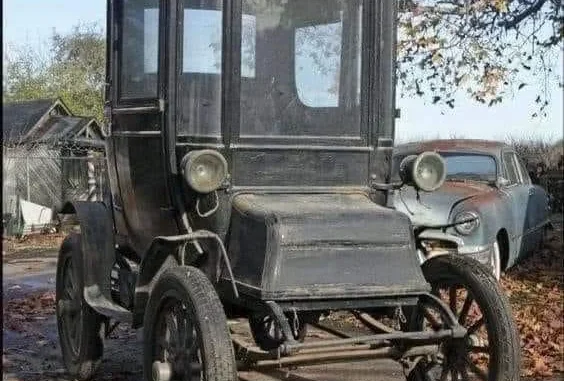
Overview of the Detroit Electric Model D
The Detroit Electric Model D was a notable achievement in the early history of electric vehicles (EVs). Produced by the Anderson Electric Car Company in Detroit, Michigan, this vehicle marked a significant step in EV technology when it debuted in 1910. The Model D boasted an impressive range of about 100 miles per charge and could achieve speeds up to 25 mph, making it competitive with many of its gasoline-powered counterparts.
Design and Build
Characterized by its sleek and luxurious appearance, the Model D embodied the design aesthetics of early 20th-century high-end automobiles. It was powered by a rear-mounted electric motor, driven by a rechargeable lead-acid battery pack. The vehicle’s chassis combined wooden components with steel reinforcements for enhanced durability.
Performance and Capabilities
With a range of approximately 100 miles per charge, the Model D was ideal for urban commuting and short journeys. Its top speed of 25 mph was sufficient for city and suburban driving, though it was outpaced by faster gasoline cars on longer routes.
Market Appeal
Detroit Electric vehicles attracted affluent city dwellers who appreciated their quiet operation and environmental benefits. High-profile individuals such as Thomas Edison, Clara Ford (Henry Ford’s wife), and John D. Rockefeller Jr. were among the notable owners of these vehicles. The brand was particularly popular among women, who favored its quiet performance and ease of use.
Production and Decline
Manufactured from 1907 until 1939, the Detroit Electric cars enjoyed a solid reputation. However, the rise of affordable gasoline vehicles, advancements in internal combustion engines, and the development of improved road infrastructure contributed to a decline in electric vehicle popularity during the 1930s.
Legacy and Resurgence
While electric cars like the Model D faced a decline in the early 20th century, interest in electric vehicles revived significantly in the late 20th and early 21st centuries. Renewed focus on environmental issues such as air pollution and climate change has led to a resurgence in electric vehicle technology, with early innovators like Detroit Electric paving the way for contemporary developments.
Advantages of Electric Vehicles
The Model D offered several benefits over gasoline-powered cars, including smoother operation, reduced maintenance needs (no oil changes or gas refills), and easier starting in cold weather due to the absence of combustion.
Charging Facilities
In the early 1900s, EV owners typically recharged their vehicles at home using connections to the electrical grid. While some cities had public charging stations, they were not as prevalent as gasoline refueling stations.
Battery Technology
Early electric vehicles, including the Model D, utilized lead-acid batteries, which were relatively heavy, had limited energy capacity, and required frequent maintenance, such as adding distilled water. These early batteries were rudimentary compared to today’s advanced lithium-ion technologies.
Market Limitations
Despite their advantages, electric vehicles like the Model D were confined to a niche market of wealthy consumers due to their high cost, limited range, and the greater convenience of gasoline cars.
Environmental Impact
Although early electric vehicles were cleaner than gasoline cars in terms of emissions, the electricity used often came from coal-fired plants, contributing to pollution. Nonetheless, these vehicles helped reduce local air pollution in urban areas.
Customization and Luxury
The Detroit Electric Model D was known for its customization options. Buyers could select from various body styles, interior materials, and features, resulting in a highly personalized vehicle. These cars were considered luxurious, with fine craftsmanship and upscale details.
Innovations in Electric Vehicle Technology
The early 20th century saw continuous experimentation with electric vehicle technology. Innovators worked on new battery formulations, motor designs, and charging methods to enhance performance and usability, laying the groundwork for future advancements.
Commercial and Industrial Applications
Electric vehicles like the Model D also found use in commercial and industrial settings. Electric trucks, delivery vans, and buses were employed in cities for local transportation and deliveries, benefiting from their quiet operation and zero emissions.
Cultural and Social Significance
In the early 20th century, electric cars symbolized progress and were linked to broader social movements, such as women’s suffrage, providing independent transportation at a time when driving was less common for women.
Reliability and Endurance
Despite the limitations of early battery technology, the Model D was known for its reliability and longevity. Electric motors, with fewer moving parts than internal combustion engines, required less maintenance and were less prone to mechanical issues.
Marketing Strategies
The Anderson Electric Car Company employed various marketing tactics to highlight the benefits of electric vehicles, emphasizing their convenience and cleanliness. Advertising campaigns targeted urban residents and women, showcasing the advantages of quiet operation and the absence of exhaust fumes.
Range Limitations and Charging Challenges
Although the Model D had a respectable range for its time, drivers still faced challenges related to range anxiety and limited charging infrastructure. Long trips required careful planning and access to charging stations, making the Model D more suited for short-distance travel.
Celebrity Endorsements
The popularity of early electric vehicles was bolstered by endorsements from prominent figures. Wealthy individuals, including actors, business leaders, and politicians, frequently owned and praised electric cars, helping to elevate their status and visibility.
Global Influence
The impact of electric vehicles extended beyond the United States, with manufacturers in Europe and other regions producing their own models. French, English, and German companies developed unique electric vehicles for local markets, reflecting the global recognition of electric transportation as a viable alternative to gasoline-powered cars.
Leave a Reply